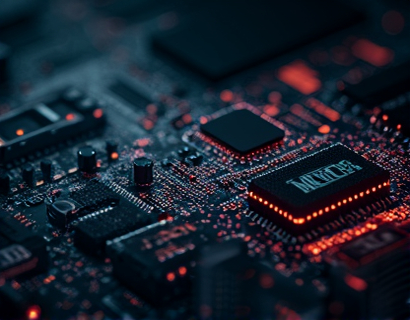Next-Gen Smart Contract AMMs: Revolutionizing DeFi Trading
The landscape of decentralized finance (DeFi) is rapidly evolving, driven by technological advancements and innovative solutions. Among these, smart contract-based Automated Market Makers (AMMs) are gaining significant traction, particularly with the introduction of next-generation models that incorporate advanced automation and sophisticated liquidity management. This article delves into the intricacies of these cutting-edge AMMs, exploring how they are elevating the trading experience for crypto traders and DeFi enthusiasts.
Understanding Traditional AMMs
Before diving into the next-gen AMMs, it's essential to understand the foundational concepts of traditional AMMs. Automated Market Makers are decentralized protocols that facilitate trading without order books, relying instead on mathematical formulas to determine asset prices. The most common model is the Constant Product Market Maker (CPMM), where the product of the liquidity provider's tokens remains constant, typically represented as x * y = k. This model ensures liquidity and allows for seamless trading, but it also has limitations, particularly in terms of price efficiency and liquidity provision incentives.
Limitations of Traditional AMMs
While traditional AMMs have been instrumental in the growth of DeFi, they come with several challenges. One major issue is the impermanent loss incurred by liquidity providers when asset prices fluctuate. This occurs because the ratio of tokens in a liquidity pool changes, leading to a discrepancy between the value of the tokens held in the pool and the value if they were held outside. Additionally, traditional AMMs often suffer from low efficiency in price discovery, especially for less liquid assets, and can be vulnerable to front-running and other forms of manipulation.
Introducing Next-Gen Smart Contract AMMs
To address these limitations, next-generation AMMs have emerged, leveraging advanced smart contract capabilities and innovative protocols. These AMMs focus on enhancing liquidity management, improving price efficiency, and automating trading strategies to provide a superior user experience. Key features of these next-gen AMMs include dynamic fee structures, advanced liquidity incentives, and sophisticated order matching algorithms.
Dynamic Fee Structures
One of the most significant advancements in next-gen AMMs is the implementation of dynamic fee structures. Unlike traditional AMMs that apply a fixed fee rate, these AMMs adjust fees based on market conditions and liquidity levels. During periods of high volatility or low liquidity, fees can increase to attract more liquidity providers, thereby stabilizing the market. Conversely, during stable periods, fees can decrease to encourage more trading activity. This adaptive approach not only enhances liquidity provision but also ensures fair compensation for liquidity providers.
Advanced Liquidity Incentives
Next-gen AMMs employ sophisticated liquidity incentives to attract and retain liquidity providers. These incentives go beyond simple fee shares and include token rewards, staking opportunities, and access to exclusive decentralized applications (dApps). For instance, some protocols offer liquidity providers a portion of the trading fees in a governance token, which can be used to vote on protocol upgrades or redeemed for other assets. Additionally, liquidity providers may receive bonus tokens for maintaining large liquidity pools or for participating in specific trading activities, further aligning their interests with the health of the ecosystem.
Sophisticated Order Matching Algorithms
To improve price efficiency and reduce slippage, next-gen AMMs utilize advanced order matching algorithms. These algorithms consider multiple factors, including order size, market depth, and historical trading patterns, to match orders more effectively. For example, some protocols use machine learning models to predict price movements and optimize order execution, ensuring that traders receive the best possible price for their trades. This level of sophistication not only enhances the trading experience but also attracts more users to the platform.
Enhanced Liquidity Management
Effective liquidity management is crucial for the success of any AMM. Next-gen AMMs introduce several innovations in this area to ensure optimal liquidity levels and minimize risks. One such innovation is the use of liquidity pools with multiple token pairs, allowing for cross-asset liquidity provision. This approach not only increases the overall liquidity in the ecosystem but also provides traders with more flexible trading options.
Another key feature is the implementation of liquidity wrappers, which enable users to lock their assets into a liquidity pool while earning passive income. These wrappers often come with built-in risk management tools, such as automatic rebalancing and stop-loss orders, to protect against adverse market movements. Additionally, some protocols offer liquidity aggregation services, allowing users to pool their liquidity across multiple AMMs to maximize yields and minimize exposure to any single protocol's risks.
Automated Trading Strategies
Automation is a cornerstone of next-gen AMMs, and one of the most exciting developments is the integration of automated trading strategies (ATS). These strategies leverage smart contracts to execute trades based on predefined criteria, such as price movements, market conditions, and portfolio balances. ATS can significantly enhance the trading experience by reducing the need for manual intervention and minimizing emotional decision-making.
For instance, some AMMs offer built-in ATS that use technical indicators and fundamental analysis to identify trading opportunities. These strategies can automatically enter and exit positions, manage risk, and optimize returns. Users can customize these strategies to align with their investment goals and risk tolerance, providing a high degree of flexibility and control. Moreover, the transparency of smart contracts ensures that all trading logic is open for review, fostering trust and reliability.
Use Cases and Applications
The benefits of next-gen smart contract AMMs extend beyond just trading. These platforms can serve as a foundation for a wide range of DeFi applications, including lending, borrowing, and yield farming. For example, liquidity provided to an AMM can be used as collateral for loans, enabling users to borrow assets without the need for traditional financial intermediaries. Additionally, the governance tokens issued to liquidity providers can be used to participate in protocol governance, creating a truly decentralized and community-driven ecosystem.
Another exciting application is the integration of next-gen AMMs with decentralized exchanges (DEXs) and other DeFi protocols. By forming interconnected networks, these platforms can offer seamless trading experiences across multiple assets and protocols, enhancing liquidity and user engagement. This interconnectedness also fosters innovation, as developers can build on existing protocols to create new and more complex financial instruments.
Challenges and Future Directions
Despite the numerous advantages, next-gen smart contract AMMs face several challenges that need to be addressed to achieve widespread adoption. One major concern is the complexity of smart contracts, which can lead to security vulnerabilities. Ensuring the robustness and auditing of these contracts is crucial to maintaining user trust and preventing potential exploits.
Another challenge is the user experience. While the underlying technology is sophisticated, the interface and usability need to be intuitive and accessible to a broader audience. Developing user-friendly dashboards and providing educational resources can help demystify the trading process and attract more users.
Looking ahead, the future of next-gen AMMs is promising. Continued advancements in smart contract technology, such as the adoption of layer 2 solutions and cross-chain interoperability, will further enhance performance and scalability. Additionally, the integration of artificial intelligence and blockchain analytics can provide deeper insights into market trends and user behavior, enabling more sophisticated trading strategies and better risk management.
Conclusion
Next-gen smart contract AMMs represent a significant leap forward in the DeFi space, offering enhanced liquidity management, advanced automation, and improved trading experiences. By addressing the limitations of traditional AMMs and leveraging cutting-edge technology, these platforms are poised to play a pivotal role in the future of decentralized finance. As the ecosystem continues to evolve, users can expect even more innovative solutions that further democratize access to financial markets and empower crypto traders and DeFi enthusiasts alike.











































